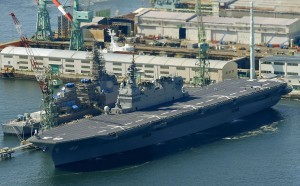2015-03-27 The Japanese are deploying their largest warship in the post-war period.
The ship is focused on carrying helicopters but will be operate the Osprey as well.
The ship is about 250 meters and displaces 19,500 tons.
According to an article published in The Asahi Shimbun on March 25, 2015 about the commissioning of the Izumo:
The Maritime Self-Defense Force on March 25 officially commissioned the largest ship in its fleet, a massive destroyer that gives it the capability of detecting highly advanced Chinese submarines.
Defense Minister Gen Nakatani attended a ceremony in Yokohama’s Isogo Ward for the official launching of the Izumo as a ship flying the MSDF flag.
“This heightens our ability to deal with Chinese submarines that have become more difficult to detect,” an MSDF officer said.
The Izumo measures 248 meters in length, leading some, including media in China and South Korea, to describe it as a “semi-aircraft carrier.” It is 51 meters longer than the destroyer Hyuga, which was the largest ship in the MSDF fleet until now.
Jane’s Fighting Ships, a respected reference book on the world’s warships released annually in Britain, describes the Izumo as a helicopter carrier.
The Izumo has five landing spots on its flight deck for reconnaissance helicopters that can locate submarines. It can carry up to nine helicopters at a time, five more than the Hyuga.
The Osprey transport aircraft that the Ground SDF will deploy in the fiscal year beginning in April can also land on the Izumo.
The Izumo joined the MSDF’s Escort Flotilla 1, which is based in Yokosuka, Kanagawa Prefecture.
Construction on the ship began in fiscal 2010, and total costs were about 120 billion yen ($1 billion).
Although much of the global press buzz on the new “aircraft carrier,” the real news is that the Japanese and South Koreans, two of the premier shipbuilders in the world, are now building amphibious ships.

And in South Korea’s case, they have transferred technology to the United States in building Military Sealift Command ships.
And an article published earlier this year by The Asahi Shimbun highlighted the capabilities of the ship and downplayed the aircraft carrier focus of the Chinese and others in Asia.
The Maritime Self-Defense Force’s newest ship has a flight deck its entire length and is nearly the size of the Shokaku and Zuikaku aircraft carriers that took part in the 1941 attack on Pearl Harbor, yet Japan insists it is not an aircraft carrier.
With a length of about 250 meters and standard displacement of 19,500 tons, the Izumo is the biggest ship in the fleet. Up to nine helicopters can land on its deck at the same time.
Even so, the Defense Ministry and MSDF insist the Izumo, which was launched last summer, is simply a destroyer capable of carrying helicopters.
Media in China and South Korea played up the launching, calling the Izumo a “semi-aircraft carrier” and evidence of a rightward tilt in Japan’s policies.
Military journalist Shinichi Kiyotani said: “Under international standards, it is nothing less than an aircraft carrier. The government is gradually expanding its interpretation because it is afraid it could become a political problem.”
For its part, Jane’s Fighting Ships, a reference book on all the world’s warships released annually in Britain, describes the Izumo as a helicopter carrier.
The Izumo is scheduled to replace the destroyer Shirane based at the MSDF base in Maizuru, Kyoto Prefecture, in spring 2015. The Shirane has a standard displacement of 5,200 tons.
The MSDF already has two other helicopter-carrying destroyers with standard displacements in excess of 10,000 tons: the Hyuga and the Ise. Another ship on the same scale as the Izumo is also under construction, meaning the MSDF will eventually maintain four of the large ships.
The Mid-Term Defense Program approved by the Abe Cabinet in December placed the four helicopter-carrying destroyers as the core vessels of the nation’s escort flotillas.
Some ships are defined by their duty, such as submarines and transport ships. However, all large surface ships whose primary mission is combat-related are defined as destroyers.
Katsutoshi Kawano, the chief of staff of the MSDF, said, “Under regulations, there is no other way to refer to the ship but as a destroyer.”
The government issued a statement in 1988 on deploying of aircraft carriers. The document stated that the SDF would not possess intercontinental ballistic missiles, strategic bombers or attack aircraft carriers.
With Japan maintaining an exclusive defensive posture, aircraft carriers like those used by the U.S. Navy, which are capable of projecting force against both sea and land targets with their fighter jets, were not considered conducive to that policy.
Defense Ministry officials said there are no plans for the Izumo to carry fighter jets. Rather, they insisted the Izumo is a multipurpose ship that will be used to deal with natural disasters or international emergency rescue operations.
To address concerns the Izumo can handle vertical landing fighter jets, such as the F-35B, a high-ranking Defense Ministry official said, “While retrofitting might be possible, it would be impossible realistically since it would require huge amounts of time and money, including the purchase of the jets and the training of the necessary personnel…..”
It seems clear that the coming of the Osprey is part of the Izumo’s future and as the USN-USMC team works through the role of the Osprey in coalition concepts of operations, they will work closely with Japan without a doubt.
For a video from NHK which highlights the commissioning of the Izumo and highlight its role including the coming of the Osprey see the following link:
http://www3.nhk.or.jp/nhkworld/english/news/japanindepth/20150325.html

